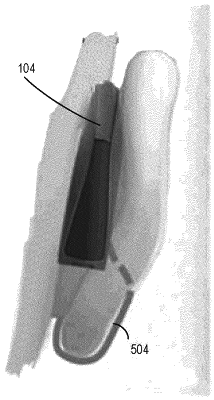| CPC A61N 5/0622 (2013.01) [A61N 5/0618 (2013.01); A61N 2005/0626 (2013.01); A61N 2005/0652 (2013.01); A61N 2005/0653 (2013.01); A61N 2005/0663 (2013.01)] | 11 Claims |

|
1. A method for non-invasively stimulating an optogenetic vagus nerve of a subject, the method comprising:
wrapping a flexible substrate of a stimulation and monitoring device around a portion of the subject's ear such as to place an adhesive of the flexible substrate in direct contact with skin of the subject's outer ear and to have a first portion of said flexible substrate contact the subject's ear adjacent to the optogenetic vagus nerve,
wherein the device includes:
said flexible substrate carrying a two-dimensional array of organic light emitting diodes (OLEDs) and one or more photodiode, each disposed on a first surface of the flexible substrate,
the two-dimensional array of OLEDs being positioned on the first portion of said flexible substrate between a reflective cathode and a transparent anode, the transparent anode being in direct contact with the flexible substrate,
OLEDs of at least a portion of the array of OLEDs being spaced on the flexible substrate relative to the one or more photodiode such as to oppose other OLEDs when the flexible substrate is wrapped around the portion of the subject's ear,
the adhesive disposed on an opposing surface relative to the first surface,
delivering light generated by the OLEDs to the optogenetic vagus nerve and said one of more photodiodes after said light has passed through one or more blood vessels in the subject's ear to monitor heart rate variability (HRV) of the subject with said one or more photodiodes;
stimulating the optogenetic vagus nerve of the subject with pulsed light generated by the OLEDs by providing pulsed electrical current to the OLEDs from a voltage-generating unit that is in operable communication with said OLEDs, and
generating an HRV signal indicating a degree of HRV of the subject based on a signal generated by the one or more photodiodes.
|